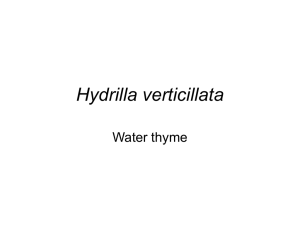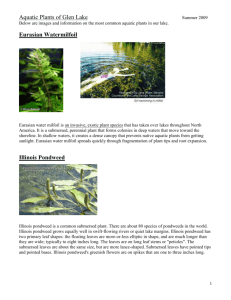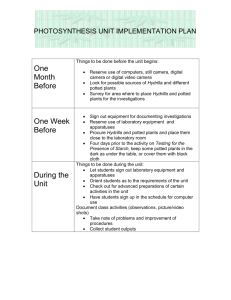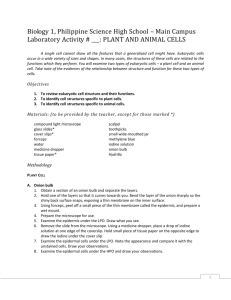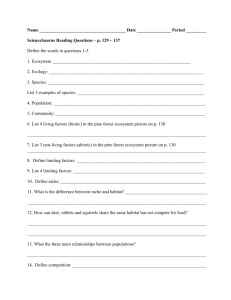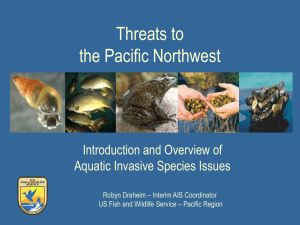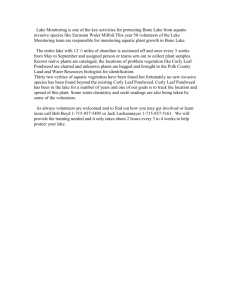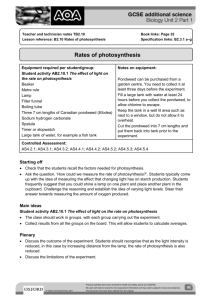Interactions Between American Pondweed and Monoecious Hydrilla
advertisement
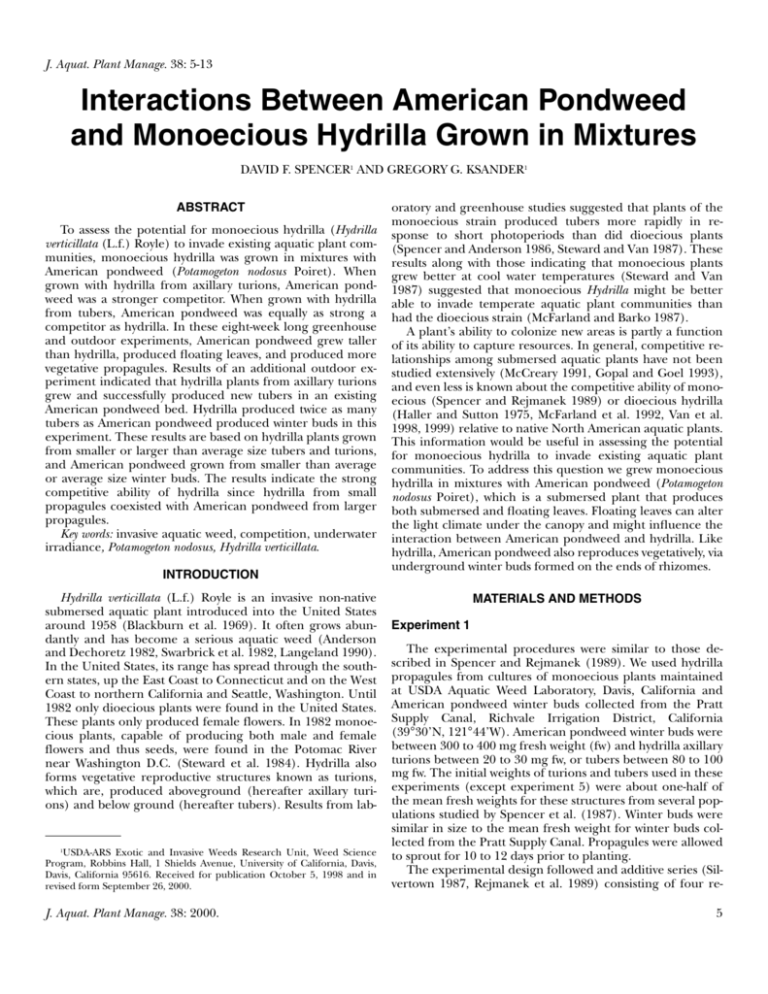
J. Aquat. Plant Manage. 38: 5-13 Interactions Between American Pondweed and Monoecious Hydrilla Grown in Mixtures DAVID F. SPENCER1 AND GREGORY G. KSANDER1 ABSTRACT To assess the potential for monoecious hydrilla (Hydrilla verticillata (L.f.) Royle) to invade existing aquatic plant communities, monoecious hydrilla was grown in mixtures with American pondweed (Potamogeton nodosus Poiret). When grown with hydrilla from axillary turions, American pondweed was a stronger competitor. When grown with hydrilla from tubers, American pondweed was equally as strong a competitor as hydrilla. In these eight-week long greenhouse and outdoor experiments, American pondweed grew taller than hydrilla, produced floating leaves, and produced more vegetative propagules. Results of an additional outdoor experiment indicated that hydrilla plants from axillary turions grew and successfully produced new tubers in an existing American pondweed bed. Hydrilla produced twice as many tubers as American pondweed produced winter buds in this experiment. These results are based on hydrilla plants grown from smaller or larger than average size tubers and turions, and American pondweed grown from smaller than average or average size winter buds. The results indicate the strong competitive ability of hydrilla since hydrilla from small propagules coexisted with American pondweed from larger propagules. Key words: invasive aquatic weed, competition, underwater irradiance, Potamogeton nodosus, Hydrilla verticillata. INTRODUCTION Hydrilla verticillata (L.f.) Royle is an invasive non-native submersed aquatic plant introduced into the United States around 1958 (Blackburn et al. 1969). It often grows abundantly and has become a serious aquatic weed (Anderson and Dechoretz 1982, Swarbrick et al. 1982, Langeland 1990). In the United States, its range has spread through the southern states, up the East Coast to Connecticut and on the West Coast to northern California and Seattle, Washington. Until 1982 only dioecious plants were found in the United States. These plants only produced female flowers. In 1982 monoecious plants, capable of producing both male and female flowers and thus seeds, were found in the Potomac River near Washington D.C. (Steward et al. 1984). Hydrilla also forms vegetative reproductive structures known as turions, which are, produced aboveground (hereafter axillary turions) and below ground (hereafter tubers). Results from lab- 1 USDA-ARS Exotic and Invasive Weeds Research Unit, Weed Science Program, Robbins Hall, 1 Shields Avenue, University of California, Davis, Davis, California 95616. Received for publication October 5, 1998 and in revised form September 26, 2000. J. Aquat. Plant Manage. 38: 2000. oratory and greenhouse studies suggested that plants of the monoecious strain produced tubers more rapidly in response to short photoperiods than did dioecious plants (Spencer and Anderson 1986, Steward and Van 1987). These results along with those indicating that monoecious plants grew better at cool water temperatures (Steward and Van 1987) suggested that monoecious Hydrilla might be better able to invade temperate aquatic plant communities than had the dioecious strain (McFarland and Barko 1987). A plant’s ability to colonize new areas is partly a function of its ability to capture resources. In general, competitive relationships among submersed aquatic plants have not been studied extensively (McCreary 1991, Gopal and Goel 1993), and even less is known about the competitive ability of monoecious (Spencer and Rejmanek 1989) or dioecious hydrilla (Haller and Sutton 1975, McFarland et al. 1992, Van et al. 1998, 1999) relative to native North American aquatic plants. This information would be useful in assessing the potential for monoecious hydrilla to invade existing aquatic plant communities. To address this question we grew monoecious hydrilla in mixtures with American pondweed (Potamogeton nodosus Poiret), which is a submersed plant that produces both submersed and floating leaves. Floating leaves can alter the light climate under the canopy and might influence the interaction between American pondweed and hydrilla. Like hydrilla, American pondweed also reproduces vegetatively, via underground winter buds formed on the ends of rhizomes. MATERIALS AND METHODS Experiment 1 The experimental procedures were similar to those described in Spencer and Rejmanek (1989). We used hydrilla propagules from cultures of monoecious plants maintained at USDA Aquatic Weed Laboratory, Davis, California and American pondweed winter buds collected from the Pratt Supply Canal, Richvale Irrigation District, California (39°30’N, 121°44’W). American pondweed winter buds were between 300 to 400 mg fresh weight (fw) and hydrilla axillary turions between 20 to 30 mg fw, or tubers between 80 to 100 mg fw. The initial weights of turions and tubers used in these experiments (except experiment 5) were about one-half of the mean fresh weights for these structures from several populations studied by Spencer et al. (1987). Winter buds were similar in size to the mean fresh weight for winter buds collected from the Pratt Supply Canal. Propagules were allowed to sprout for 10 to 12 days prior to planting. The experimental design followed and additive series (Silvertown 1987, Rejmanek et al. 1989) consisting of four re5 placement series with 3, 6, 9, or 12 plants per pot corresponding to 294, 588, 882, or 1176 plants m-2. For each density there were two monocultures and two ratios, 0.3 and 0.7. For example, the pots with a density of three plants per pot would have the following combinations: three hydrilla plants, two hydrilla plants with one American pondweed plant, one hydrilla plant with two American pondweed plants and three American pondweed plants. Since there were 4 densities (3, 6, 9, or 12 plants per pot) a total of 16 pots was required. One group of 16 pots was planted with hydrilla tubers and American pondweed winter buds and, a second group was planted with hydrilla axillary turions and American pondweed winter buds. Each pot (height = 12.5 cm; diameter = 12 cm) contained about 1 L of modified UC Mix (Spencer and Anderson 1986). Unless stated otherwise, all propagules were planted about 3 cm deep in the substrate. The pots were placed in plastic tubs (58 × 58 × 33 cm inside dimensions) and the plants allowed to grow in a greenhouse. In this experiment the mean daily temperature was 24C (N = 546) and the mean light intensity was 224 µmol m-2 s-1 (N = 856). After eight weeks, the plants were harvested, separated into species and the weight of each species determined following drying at 80C for 48 hours (Coombs et al. 1985, Hendry and Grime 1993). Mean plant weight was determined by dividing total weight by the number of plants per species. The following experiments were similar in design and execution except for the differences noted below. Experiment 2 This experiment compared American pondweed from winter buds (300 to 400 mg fw) with hydrilla from turions (30 to 60 mg fw) and used the same design as the turion portion of Experiment 1. This experiment was performed outside in 1000-L rectangular concrete tanks covered with a screen (as were all other outside experiments). Water in all the outdoor experiments was from a well and was approximately 0.5 m deep. Experiment 3 This outdoor experiment compared American pondweed from winter buds (300 to 400 mg fw) with hydrilla from tubers (100 to 150 mg fw). For this study, mean daily light was 1299, µmol m-2 s-1 (N = 634) and mean daily water temperature was 25C (N = 849). It used the same design as the tuber portion of Experiment 1 except that additional pots were added with the following densities: one pot with one hydrilla, one pot with one American pondweed, one pot with two hydrilla and two American pondweed, one pot with three hydrilla and three American pondweed, one pot with six hydrilla and six American pondweed, one pot with nine hydrilla and nine American pondweed, and one pot with twelve hydrilla and twelve American pondweed. The total number of pots was twenty-four. Experiment 4 This outdoor experiment compared the competitive abilities of American pondweed from large winter buds (300 to 400 mg fw) and hydrilla from small tubers (80 to 100 mg fw) 6 and axillary turions (30 to 60 mg fw). The propagules were sprouted for 11 days. The design and number of pots were as described for Experiment 3. Since there were two propagule types, the experiment required 48 total pots. The pots were placed in a 1000-L outside concrete tanks and the plants allowed to grow for 8 weeks. Experiment 5 This outdoor experiment examined competitive interactions between American pondweed from small winter buds (100 to 150 mg fw) and hydrilla from large tubers (200 to 250 mg fw). The densities and ratios were as described for Experiment 1 with the following additions: there were two pots for each ratio at total density three plants per pot, and there were two pots each that contained either one hydrilla or one American pondweed. Thus the total number of pots was 22. Statistical Analyses In all of the above experiments, competitive abilities of each species were estimated using the reciprocal yield model (Suehiro and Ogawa 1980, Watkinson 1981, Wright 1981, Spitters 1983, Rejmanek et al. 1989). This procedure uses linear multiple regression of the reciprocal of the mean plant weight for plants grown at each density combination (i.e., density of hydrilla and/or American pondweed) for each species on the density (number m-2) of each species. The linear model was selected for the following reasons. Analysis of residuals did not point to any obvious non-linearity in the data. It is a simple model whose terms are easily interpreted biologically (Spitters 1983) and the procedures for statistical comparison of the regression coefficients are more straightforward. Other authors have reported that it adequately summarized observed results for a variety of species (Suehiro and Ogawa 1980, Spitters 1983, Motomura et al. 1986, Rejmanek et al. 1989). Spitters (1983) stated that the resulting regression coefficients are measures of intra- and interspecific competition. For example in two species mixtures, the coefficients provide quantitative estimates of the reduction in growth of an individual of species 1 due to the addition of individuals of species 1 or species 2. In order to determine whether or not the competitive abilities for each species differed when hydrilla plants were grown from tubers or axillary turions we compared the appropriate multiple regression equations from Experiments 1 and 4. Statistical analyses were performed using regression procedures in SAS (SAS Institute, Inc. 1990). Light Measurements During Experiments 4 and 5, we measured light levels in the growth tanks and plant height and the number of floating leaves were also measured. After the plants in experiment 4 had been growing 4 weeks, we measured light levels in the water column using a Li-Cor model LI-189 meter (Li-Cor, Lincoln, Nebraska) with a flat surface underwater sensor. Two depth profiles were taken in an area of the tank where floating leaves were present and one in an area of open water. Four days before Experiment 5 was terminated (after approximately 7.5 weeks of growing time), light intensity at 15 cm J. Aquat. Plant Manage. 38: 2000. deep in the water was measured within a 70 cm × 120 cm grid (points were at intersection of lines 10 cm apart). A reading was taken just below the water’s surface and used in combination with the water column readings to calculate the percent of surface light present at 15 cm. Twenty-five floating leaves were collected, videotaped, and the area of each leaf estimated using the computer program Mocha (Jandel Scientific, San Rafael, California). The percentage of light transmitted through 15 individual American pondweed floating leaves was estimated from changes in light meter readings with and without a floating leaf placed over the top of the sensor. The number of floating leaves present in each grid section was determined and multiplied by the mean area of a floating leaf, to estimate the leaf area index (total area of leaves m-2). plastic tubs was planted with hydrilla axillary turions alone and two sets of three tubs each received the combinations of species describe above. The plastic tubs were submersed in 1000-L concrete tanks (2.23 × 0.79 × 0.61 m) located outdoors Water depth was about 0.5 m. The minimum/maximum water temperature was recorded at 2 to 3 day intervals. Water in the tanks was changed weekly. At 2 to 3 day intervals, the tubs were examined for 5 weeks for sprouting of winter buds or axillary turions. After 8 weeks, the plants were harvested by washing them over metal screens to remove the sediment. Plants were separated into shoots, roots and rhizomes, and newly formed propagules. Newly formed propagules were counted and weighed. This experiment ran 8 weeks, and the plants were exposed to ambient temperature and light and the natural photoperiod. Experiment 6 A separate experiment was designed to assess the ability of monoecious hydrilla grown from turions to invade areas with existing macrophyte beds. In this experiment American pondweed winter buds were planted at 5 cm deep in rectangular plastic containers (33 × 27 × 12 cm) at densities equivalent to 300 and 600 winter buds m-2. These densities and this planting depth simulated those observed in a northern California irrigation canal (Spencer and Ksander 1993, Spencer et al. 1994). Hydrilla axillary turions (300 m-2) were planted 1 cm deep to simulate conditions for turions that are likely to be deposited near the sediment surface. One set of three RESULTS Experiment 1 American pondweed mean plant weight varied from 0.35 to 0.87 g for plants grown with hydrilla from tubers and from 0.33 to 0.89 g for plant grown with hydrilla from axillary turions. Hydrilla plants from tubers grown with American pondweed ranged from 0.09 to 0.44 on average, and those from axillary turions ranged from 0.06 to 0.42. American pondweed was taller than hydrilla from either tubers or turions (Table 1). TABLE 1. PLANT CHARACTERISTICS FOR AMERICAN PONDWEED (P) FROM WINTER BUDS AND HYDRILLA FROM AXILLARY TURIONS (HA) OR TUBERS (HT), GROWN IN MIXTURES. VALUES ARE MEANS AND THE 95% CONFIDENCE INTERVALS (IN PARENTHESIS), CALCULATED OVER ALL DENSITIES. N/D INDICATES A CHARACTERISTIC WAS NOT MEASURED AND N/A DENOTES NOT APPLICABLE. TUBER/WB SIZE REFERS TO THE INITIAL SIZE OF PROPAGULES (HYDRILLA/AMERICAN PONDWEED) RELATIVE TO MEAN VALUES FROM FILED AND GREENHOUSE POPULATIONS. SEE REFERENCES IN THE TEXT. Species P with HT HT with P P with HA HA with P P with HA HA with P P with HT HT with P P with HT HT with P P with HA HA with P P with HT HT with P Plant weight (g) Length (cm) Floating leaves/Plant Propagules/Plant Experiment Tuber/WB size 0.58 (0.48 to 0.69) 0.22 (0.14 to 0.30) 0.54 (0.43 to 0.65) 0.18 (0.11 to 0.26) 0.77 (0.61 to 0.93) 0.16 (0.11 to 0.22) 1.05 (0.52 to 1.29) 0.90 (0.52 to 1.29) 3.13 (2.33 to 3.93) 0.14 (0.09 to 0.19) 3.09 (2.04 to 4.13) 0.19 (0.01 to 0.37) 2.31 (1.26 to 3.36) 1.64 (2.90 to 1.08) 42.8 (39.2 to 42.8) 33.0 (39.3 to 36.7) 42.7 (37.8 to 47.5) 25.5 (22.2 to 28.8) N/D 18.5 (12.1 to 24.9) N/A 1.0 (0.8 to 1.2) 0 1 < Mean, Mean 13.0 (9.2 to 16.8) N/A 1.0 (0.8 to 1.2) 0 1 N/D 2 N/D N/D 58.2 (51.3 to 65.2) 22.6 (9.8 to 35.3) 82.7 (79.5 to 85.8) 36.8 (28.2 to 45.4) 80.6 (77 to 84.2) 34.1 (27.5 to 40.7) 74.6 (67.1 to 82.1) 58.0 (54.8 to 61.2) 6.4 (3.6 to 9.2) N/A 1.4 (1.0 to 1.7) 0.1 (-0.002 to 0.3) 1.6 (1.3 to 1.8) 0 J. Aquat. Plant Manage. 38: 2000. 36.9 (27.0 to 46.8) N/A 31.2 (21.4 to 40.9) N/A 33.3 (17.8 to 48.7) N/A 5.2 (3.6 to 6.8) 0.20 (0.05 to 0.35) 4.9 (3.6 to 6.8) 0 8.4 (4.4 to 12.3) 1.6 (0.4 to 2.9) 1 1 < Mean, Mean 2 3 < Mean, Mean 3 4 < Mean, Mean 4 4 4 5 > Mean, < Mean 5 7 American pondweed produced floating leaves and winter buds. Hydrilla did not produce tubers during this experiment. Regression analysis of the interaction between American pondweed and hydrilla from tubers yielded Eqs. 1 and 2 in Table 2. One data point was excluded from this analysis as an outlier (Figure 1) because the studentized residual was 3.53 (Schlotzhauer and Littell 1987, p. 337). In Eq. 1, the difference between the partial regression coefficients was marginally significant indicating that intraspecific competition from other American pondweed was stronger than interspecific competition from hydrilla. Eq. 2 summarizes the effects of American pondweed and hydrilla density on hydrilla grown from tubers. The difference between the partial regression coefficients was not significant, indicating that a single hydrilla grown from a tuber suppresses hydrilla as much as a single American pondweed. Regression analysis of the interaction between American pondweed and hydrilla grown from axillary turions produced Eqs. 3 and 4 (Table 2, Figure 2). For Eq. 3, the difference between the partial regression coefficients was not significant. This indicates that these data do not provide evidence that the effects of intra- and interspecific competition differ. Thus a single American pondweed suppresses American pondweed growth as much as a single hydrilla grown from an axillary turion. For Eq. 4, the difference between the partial regression coefficients was marginally significant. The magnitude of the ratio of the coefficients indicates that a single hydrilla grown from an axillary turion suppresses growth of another hydrilla plant from an axillary turion about onehalf as strongly as does a single American pondweed. Table 3 presents the results of a comparison of the regression surfaces from Experiment 1. In this analysis significant interaction terms between species density and propagule type indicate that the effects of density were not the same for both propagule types. The only significant interaction was between American pondweed density and propagule type when hydrilla weight was the response variable. This indicates that American pondweed density had a greater effect on hydrilla weight when hydrilla was grown from axillary turions instead of tubers. The lack of significance for other interaction terms indicates that the effects of density were similar for each propagule type. Experiment 2 In Experiment 2, mean American pondweed weight varied from 0.50 to 1.20 g for plants grown with hydrilla from turions. The average weight for hydrilla plants from axillary turions grown with American pondweed ranged from 0.03 to 0.37 g. American pondweed produced more vegetative propagules per plant than hydrilla (Table 1). Regression analysis for the interaction between hydrilla from tubers and American pondweed produced Eq. 5 and 6 in Table 2. For Eq. 5, the difference between the partial regression coefficients was not significant, indicating that for American pondweed competition from another American pondweed plant was similar to that from a single hydrilla plant grown form a tuber. Similarly for Eq. 6, the lack of a significant difference between the partial regression coefficients (Table 2) did not provide evidence for differences in competitive abilities with respect to effects on growth of hydrilla from tubers. Experiment 3 Figure 1. Multiple regression of reciprocal mean plant weight (I/W, plants g -1) of hydrilla (H. verticillata) (A) from tubers and American pondweed (P. nodosus) (B) grown from winter buds. Dots represent actual data points and the vertical lines between the dot and the regression surface indicate residuals. In panel B, the half-tone dot represents a data point that was not included in the regression analysis based on the value of the studentized residual. Densities expressed as number m-2. 8 In Experiment 3, American pondweed varied from 0.26 to 2.83 g while hydrilla from tubers ranged from 0.21 to 3.32 g. American pondweed were taller than hydrilla from tubers (Table 1). They produced floating leaves and on average 1.6 winter buds per plant. Hydrilla did not produce tubers during this experiment. Eq. 7 and 8 (Table 2) summarize the interaction between American pondweed and hydrilla grown from axillary turions in this experiment. Comparison of the partial regression coefficients for hydrilla and pondweed in Eq. 7 indicates that the effects of adding a single American pondweed or a single hydrilla from an axillary turion on American pondweed were similar. In contrast, Eq. 8 indicates J. Aquat. Plant Manage. 38: 2000. TABLE 2. REGRESSION EQUATIONS FOR INVERSE LINEAR MODEL. W IS THE MEAN INDIVIDUAL PLANT WEIGHT (G) AND N IS THE DENSITY (M-2); THE SUBSCRIPT DENOTES THE SPECIES EITHER AMERICAN PONDWEED (P), HYDRILLA (HT) GROWN WITH TUBERS OR HYDRILLA GROWN FROM AXILLARY TURIONS (HA). Eq. Regression equation Estimate of the difference between partial regression coefficients 1 2 1/WP = 1.11 + 1.17 × 10-3 NP + 0.22 × 10-3 NHT 1/WHT = 0.12 + 7.98 × 10-3 NHT + 7.58 × 10-3 NP -0.95 × 10-3 -0.59 × 10-3 0.08 0.20 1 1 3 4 1/WP = 0.94 + 1.65 × 10-3 NP + 1.05 × 10-3 NHT 1/WHA = 0.08 + 8.72 × 10-3 NHA + 13.5 × 10-3 NP 0.39 × 10-3 -4.80 × 10-3 0.84 0.10 1 1 5 6 1/WP = 0.82 + 0.78 × 10-3 NP + 0.35 × 10-3 NHT 1/WHA = 0.84 + 1.58 × 10-3 NHT + 0.48 × 10-3 NP 0.56 × 10-3 0.17 × 10-3 0.61 0.73 2 2 7 8 1/WP = 0.90 + 0.74 × 10-3 NP + 0.57 × 10-3 NHA 1/WHA = 0.49 + 7.13 × 10-3 NHA + 26.0 × 10-3 NP -1.09 × 10-3 18.9 × 10-3 0.41 0.09 3 3 9 10 1/WP = 0.23 + 0.37 × 10-3 NP - 0.02 × 10-3 NHT 1/WHT = 16.6 - 9.64 × 10-3 NHT - 4.34 × 10-3 NP 0.38 × 10-3 -5.3 × 10-3 0.0005 0.71 4 4 11 12 1/WP = 0.18 + 0.48 × 10-3 NP + 0.06 × 10-3 NHA 1/WHA = 56.1 - 45.4 × 10-3 NHA - 54.6 × 10-3 NP 0.42 × 10-3 -0.92 × 10-3 0.01 0.76 4 4 13 14 1/WP = 0.22 + 0.76 × 10-3 NP + 0.42 × 10-3 NHT 1/WHT = 0.36 + 0.14 × 10-3 NHT + 0.13 × 10-3 NP 0.34 × 10-3 -0.01 × 10-3 0.49 0.98 5 5 that adding a single hydrilla plant from an axillary turion has about one-third the effect on the average hydrilla weight as did adding a single American pondweed plant (Table 2) Experiment 4 In Experiment 4, American pondweed was taller, weighed more, and produced more propagules than hydrilla from either tubers or turions (Table 1). Regression analysis produced Eq. 9 to 12 (Table 2). Examination of the partial regression coefficients in Eq. 9 indicates that, American pondweed was more strongly influenced by intraspecific competition than by competition from hydrilla plants from tubers. In this experiment, hydrilla plants from tubers were quite small on average and were not strongly affected by the presence of either other hydrilla plants or American pondweed plants (Eq. 10). The partial regression coefficients in Eq. 10 did not differ from zero and thus the negative signs associated with them, while representing the parameters resulting in the “best fit” have no specific biological meaning. Comparison of partial regression coefficients for American pondweed and hydrilla from axillary turions (Eq. 11 and 12) gave results quite similar to those for Eq. 9 and 10. Table 3 presents the results of a comparison of the regression surfaces from Experiment 4. There were no significant interaction terms, indicating that propagule type (tuber or axillary turion) did not affect competitive ability of hydrilla in this experiment. Experiment 5 In Experiment 5, American pondweed was taller, weighed more, and produced more vegetative propagules than hydrilla from tubers (Table 1). However, the differences were not as great as observed in Experiment 4 (Table 1). Regression results indicate that the addition of either hydrilla or AmeriJ. Aquat. Plant Manage. 38: 2000. Prob >T-statistic for Ho: difference = 0 Experiment can pondweed plants produced similar reduction in American pondweed mean weight (Table 2, Eq. 13). In this experiment, intra- and interspecific competition on American pondweed were similar in magnitude. A similar equivalence in intra- and interspecific competition was observed for hydrilla plants grown from tubers (Table 2, Eq. 14). Light Measurements Light (PAR) passing through American pondweed floating leaves was reduced an average of 87% (Table 4). Under the conditions present in Experiment 5, mean leaf area for an individual American pondweed floating leaf was 7.09 cm2. The presence of American pondweed floating leaves clearly influenced underwater light levels in Experiments 4 and 5. Depth profiles of light (PAR), taken in portions of the tank where American pondweed floating leaves were present indicated that underwater light levels were reduced by 89% (Figure 3), very similar to results for individual leaves (Table 4). In Experiment 5, the presence of floating leaves clearly caused a reduction in underwater light levels (Figure 4). Experiment 6 In Experiment 6, hydrilla from axillary turions became established in American pondweed beds. Comparison of means and standard errors indicates that biomass of hydrilla shoots, rhizomes + roots, and tubers was unaffected by the presence of 300 or 600 American pondweed m-2 (Figure 5). The natural photoperiods in this experiment were favorable to tuber production with hydrilla producing about 1000 tubers m-2 regardless of American pondweed density. Since American pondweed was not grown in monoculture for this experiment, it is not possible to determine the reduction of American pondweed growth due to the presence of hydrilla. But American pondweed in mixtures grew sufficiently well to 9 Figure 2. Multiple regression of reciprocal mean plant weight (I/W, plants g -1) of hydrilla (H. verticillata) (A) from turions and American pondweed (P. nodosus) (B) grown from winter buds. Dots represent actual data points and the vertical lines between the dot and the regression surface indicate residuals. Densities expressed as number m-2. produce from 200 to 500 winter buds m-2 depending on the density of American pondweed (Figure 5). In this experiment, sprouting and emergence from the sediment by hydrilla occurred earlier and at a higher rate than for American pondweed. Due to the timing of this experiment, the water temperature (Figure 6) may have been warmer than would occur naturally in more northern habitats. DISCUSSION In experiments 1 through 5, increasing plant density led to reduced individual plant weights for one or both species. Decreased growth of individual submersed aquatic plants as a function of increasing plant density has been reported for Vallisneria americana (Titus and Stephens 1983), Eleocharis acicularis and Juncus pelocarpus forma submersus (McCreary and 10 Carpenter 1987), P. pectinatus and Myriophyllum exalbescens (Moen and Cohen 1989), P. pectinatus and hydrilla (Spencer and Rejmanek 1989), P. pectinatus, Ranunculus baudotii, Ruppia cirrhosa, P. perfoliatus, and P. filiformis (Kautsky 1991) and M. spicatum and M. sibiricum (Valley and Newman 1998). In experiments 1 through 5 increases in American pondweed density had effects on other American pondweed plants that were equal to or greater than effects due to increases in the density of hydrilla plants. Likewise, increases in American pondweed density led to reduced individual plant weights for hydrilla. The effects of American pondweed on hydrilla were equal or greater than the effect of other hydrilla on hydrilla. In these experiments, American pondweed’s ability to compete with hydrilla appeared to be similar across a range of water temperatures, daily irradiances and, starting propagule sizes for both species. In all five experiments, American pondweed grew taller than monoecious hydrilla plants. This observation agrees with an earlier report by McFarland et al. (1992) that American pondweed grew taller than dioecious hydrilla plants (grown from cuttings) when both species were grown in mixtures in a greenhouse on either high or low nutrient sediments. Light measurements made in Experiments 4 and 5 indicate that taller American pondweed plants that also produced floating leaves clearly altered the amount of light available to hydrilla. This alteration may partly explain American pondweed’s ability to effectively capture resources relative to hydrilla in these experiments. It has been reported that another floating-leaved species, Nelumbo lutea, suppressed dioecious Hydrilla by developing a dense leaf cover on the water surface and reducing light penetration (Johnston et al. 1983). Results from the mixture experiments (1 through 5) imply that under some circumstances American pondweed may capture resources as well as hydrilla and thus may coexist for a time with monoecious hydrilla. However, competition coefficients (calculated from data in additive series experiments) do not alone determine which species is competitively superior. Firbank and Watkinson (1985) noted that the number of propagules produced and differences in the time of emergence may offset apparent advantages indicated by competition coefficients such as these. In Experiments 1 through 5, American pondweed produced new winter buds while hydrilla propagule production was essentially zero. Spencer and Ksander (1991) reported that in 8- or 12-week experiments, hydrilla from tubers and turions were able to produce new tubers. Comparison of Spencer and Ksander’s (1991) results with those from these experiments suggest that the presence of American pondweed was responsible for reduced hydrilla propagule production in these experiments. However, this reduction may not be seen in natural populations if American pondweed does not produce similar alterations in the light environment (e.g., in flowing water systems) or if the alterations do not persist throughout hydrilla’s growing season. In fact in Experiment 6, hydrilla produced more propagules than American pondweed. Importance of the timing of emergence from the sediments is illustrated by the results of Experiment 6. In this experiment, hydrilla emerged at a greater rate than American pondweed and a higher proportion of the total number of propagules emerged than for American pondweed. The reJ. Aquat. Plant Manage. 38: 2000. TABLE 3. RESULTS OF ANALYSIS OF VARIANCE FOR COMPARISON OF TWO REGRESSION SURFACES FROM EXPERIMENT 1. NH REPRESENTS HYDRILLA DENSITY, NP REPRESENTS AMERICAN PONDWEED DENSITY, AND PROP REPRESENTS PROPAGULE TYPE. THE COLUMN LABELED ‘PR > F’ PRESENTS THE PROBABILITY OF OBTAINING A GREATER F-VALUE AS CALCULATED BY THE GLM PROCEDURE IN SAS. ADDITIONAL POTS WERE ADDED TO EXPERIMENT 4, THUS THE DIFFERENCE IN DEGREES OF FREEDOM (DF). Species Source DF Sums of squares F-value Pr > F Potamogeton nodosus Prop NP NH NP* Prop NH * Prop Error 1 1 1 1 1 17 0.024 3.846 0.503 0.108 0.211 2.204 0.21 32.3 4.23 0.91 1.78 0.65 0.0001 0.055 0.35 0.20 Hydrilla verticillata Prop NP NH NP * Prop NH * Prop Error 1 1 1 1 1 18 0.002 144.320 144.540 11.416 0.282 53.881 0 48.21 48.29 3.81 0.09 0.98 0.0001 0.0001 0.07 0.76 Potamogeton nodosus Prop NP NH NP* Prop NH * Prop Error 1 1 1 1 1 25 0.62 71.07 0.09 1.25 0.39 0.44 0.0001 0.76 0.27 0.54 Hydrilla verticillata Prop NP NH NP * Prop NH * Prop Error 1 1 1 1 1 25 Experiment 1 Experiment 4 0.005 0.517 0.0007 0.009 0.003 0.182 775.13 642.73 670.44 182.47 351.53 4251.11 sult was that American pondweed did not have the same impact on hydrilla as was observed in Experiments 1 through 5. In Experiment 6, hydrilla produced more biomass than American pondweed and also produced from 2.5 to 5 times the number of new propagules as did American pondweed. This apparent contrast may in part be due to the fact that in Experiments 1 through 5 propagules were purposely sprouted prior to planting. In Experiment 6 propagules sprouted in response to ambient environmental conditions. As suggested by Firbank and Watkinson (1985), it appears that understanding the timing of emergence from the sediment for aquatic plant propagules would contribute to predicting the outcome of competitive interactions. The results of these short-term experiments are somewhat unexpected given hydrilla’s continued range expansion in 4.38 3.63 3.79 1.03 1.98 0.05 0.07 0.06 0.32 0.17 the United States. Experiments 1 through 5 indicate that under some conditions American pondweed appears to coexist with monoecious hydrilla, and Experiment 6 demonstrates clearly that hydrilla may invade an existing American pondweed stand and produce more propagules than the residents. While results similar to those of Experiments 1 through 5 were reported by McFarland et al. (1992), there are still few studies that address the competitive ability of monoecious hydrilla relative to other species of aquatic plants. It may be possible that areas that hydrilla has successfully invaded did not have resident canopy forming species, such as American pondweed. The present results were obtained in controlled experiments that excluded environmental disturbances. The importance (if any) of disturbance in facilitating hydrilla invasion into an area is not well understood. TABLE 4. CHARACTERISTICS OF AMERICAN PONDWEED FLOATING LEAVES FROM EXPERIMENT 5. Leaf area (cm2) Light reduction/leaf (%) Mean Standard deviation Lower 95% confidence limit Upper 95% confidence limit Number of samples 7.09 87.3 2.02 7.88 6.30 83.4 7.88 91.3 25 15 J. Aquat. Plant Manage. 38: 2000. 11 Figure 3. Light intensity (PAR) versus depth for areas with American pondweed floating leaves and without floating leaves in the culture tank used in Experiment 4. These results are from experiments that used plants from propagules that were from restricted sizes. In Experiments 1 through 4 the initial weights of hydrilla axillary turions and tubers used were about one-half of the mean fresh weights for tubers from several populations reported by Spencer et Figure 5. Mean yields (g m-2) for monoecious hydrilla (H. verticillata) grown from axillary turions in monoculture (300 m -2) and in mixtures with American pondweed (P. nodosus) (300 or 600 m -2) in outdoor tanks (A). “Pro” indicates propagules, “RRh” is for roots + rhizomes, and “Sht” indicates shoots. Mean yields (g m-2) American pondweed from winter buds grown at two densities of American pondweed (300 or 600 m -2) and one density of monoecious hydrilla from axillary turions, (300 m -2) (B). Mean number of newly formed hydrilla tubers (C) and American pondweed winter buds (D). al. (1987). On the other hand winter buds were similar in size to the mean fresh weight for winter buds collected from a nearby irrigation system. Thus Experiments 1 through 4 compared competitive abilities of American pondweed plants from average size propagules with those of hydrilla plants from propagules that were about one-half of the mean Figure 4. Leaf area index for American pondweed (P. nodosus) floating leaves (A) and light intensity (PAR) at 15 cm below the surface (B) at points within a grid established in the culture tank used in Experiment 5. 12 Figure 6. Emergence of hydrilla (H. verticillata) axillary turions and American pondweed (P. nodosus) winter buds (mean ± 1 standard error) and minimum/maximum water temperatures in an outdoor tank. J. Aquat. Plant Manage. 38: 2000. size for these propagules (refer to Table 1). Viewed in the context of propagule size these results may indicate the strong competitive abilities of monoecious hydrilla plants, since plants from less than average sized propagules were able to coexist with American pondweed from larger propagules. Based on the limited information available, it would be unwise to infer that monoecious hydrilla did not pose a threat to North America native aquatic plant communities especially in view of experience with plants of the dioecious biotype. Clearly, additional research on competitive abilities of exotic and native aquatic plants under a variety of conditions is warranted. ACKNOWLEDGMENTS We appreciate the comments of Dr. Larry Mitich, Dr. Tom Lanini, Dr. Fred Ryan, and Dr. Lars Anderson who read an earlier version of the manuscript. Mention of a manufacturer does not constitute a warranty or guarantee of the product by the U.S. Department of Agriculture nor an endorsement over other products not mentioned. LITERATURE CITED Anderson, L. W. J. and N. Dechoretz. 1982. Growth, reproduction and control of Hydrilla verticillata Royle (L.f.) in an irrigation system in southwestern U.S. Proc. E.W.R.S. Symp. Aquat. Weeds. pp. 54-61. Blackburn, R. D., L. W. Weldon, R. R. Yeo, and R. M. Taylor. 1969. Identification and distribution of certain similar-appearing submerged aquatic weeds in Florida. Hyacinth Control J. 8: 17-21. Coombs, J., D. O. Hall, S. P. Long, and J. M. O. Scurlock. 1985. Techniques in bioproductivity and photosynthesis (Second Edition) Pergamon Press, New York. 298 pp. Firbank, L. G. and A. R. Watkinson 1985. On the analysis of competition within two-species mixtures of plants. J. Appl. Ecol. 22: 503-517. Gopal, B. and U. Goel. 1993. Competition and allelopathy in aquatic plant communities. Bot. Rev. 59: 155-210. Haller, W. T. and D. L. Sutton 1975. Community structure and competition between Hydrilla and Vallisneria. Hyacinth Control J. 13: 48-50 Hendry, G. A. F. and J. P. Grime. 1993. Methods in comparative plant ecology. Chapman & Hall, London. 252 pp. Johnston, D. L., D. L. Sutton, V. V. Vandiver Jr., and K. A. Langeland. 1983. Replacement of Hydrilla verticillata by other aquatic plants in a pond with emphasis on growth of American lotus (Nelumbo lutea). J. Aquat. Plant Manage. 21: 41 -43. Kautsky, L. 1991. In situ experiments on interrelationships between six brackish macrophytes species. Aquat. Bot. 39: 159-172. Langeland, K. A. 1990. Hydrilla, a continuing problem in Florida waters. Coop. Ext. Ser. Circ. No. 884, University of Florida, Gainesville. 21 pp. McCreary, N. J. 1991. Competition as a mechanism of submersed macrophyte community structure. Aquat. Bot. 41: 177-193. McCreary, N. J. and S. R. Carpenter. 1987. Density dependent growth interactions between Eleocharis acicularis (L.) R. & S. and Juncus pelocarpus forma submersus Fassett. Aquat. Bot. 27: 229-241. McFarland, D. G. and J. W. Barko. 1987. Effects of temperature and sediment type on growth and morphology of monoecious and dioecious Hydrilla. J. Freshwat. Ecol. 4: 245-252. J. Aquat. Plant Manage. 38: 2000. McFarland, D. G., J. W. Barko, and N. J. McCreary. 1992. Effects of sediment fertility and initial plant density on growth of Hydrilla verticillata (L.f.) Royle and Potamogeton nodosus Poiret. J. Freshwat. Ecol. 7: 191-200. Moen, R. A. and Y. Cohen. 1989. Growth and competition between Potamogeton pectinatus L. and Myriophyllum exalbescens Fern. in experimental ecosystems. Aquat. Bot. 33: 257-270 Motomura, S., K. Shinozaki, and K. Yoda. 1986. Competition between two similar plant varieties, green shrunk perilla and red shrunk perilla, in mixed cultures. Bot. Mag. 99: 395-405. Rejmanek, M., G. R. Robinson, and E. R. Rejmankova. 1989. Weed-crop competition: experimental designs and models for data analysis. Weed Sci. 37: 276-284. SAS Institute Inc. 1990. SAS/Stat Guide for Personal Computers, Version 6, Fourth Edition, Volume 2. SAS Institute Inc., Cary NC, 846 pp. Schlotzhauer, S. D. and R. C. Littell. 1987. SAS system for elementary statistical analysis. SAS Institute Inc., Cary, NC. 416 pp. Silvertown, J. W. Introduction to plant population ecology (Second Edition). John Wiley & Sons, Inc., New York. 229 pp. Spencer, D. F. and L. W. J. Anderson. 1986. Photoperiod responses in monoecious and dioecious Hydrilla verticillata. Weed Sci. 34: 551-557. Spencer, D. F., L. W. J. Anderson, M. D. Ames, and F. J. Ryan. 1987. Variation in Hydrilla verticillata (L.f.) Royle propagule weight. J. Aquat. Plant Manage. 25: 11-13. Spencer, D. F. and G. G. Ksander. 1991. Comparative growth and propagule production by Hydrilla verticillata grown from axillary turions or subterranean turions. Hydrobiologia 222: 153-158. Spencer, D. F. and G. G. Ksander, 1993. Spatial pattern analysis for underground propagules of Potamogeton gramineus L. in two northern California irrigation canals. J. Freshwat. Ecol. 8: 297-303. Spencer, D. F., G. G. Ksander, and L. C. Whitehand, 1994. Estimating the abundance of subterranean propagules of submersed aquatic plants. Freshwat. Biol. 31: 191-200. Spencer, D. F. and M. Rejmanek. 1989. Propagule type influences competition between two submersed aquatic macrophytes. Oecologia 81: 132-137. Spitters, C. J. T. 1983. An alternative approach to the analysis of mixed cropping experiments. I. Estimation of competition effects. Neth. J. Agric. Sci. 31: 1-11. Steward, K. K. and T. K. Van. 1987. Comparative studies of monoecious and dioecious hydrilla (Hydrilla verticillata) biotypes. Weed Sci. 35: 204-210. Steward, K. K., T. K. Van, V. Carter, and A. H. Pieterse. 1984. Hydrilla invades Washington, D.C. and the Potomac. Am. J. Bot. 71: 162-163. Suehiro, K. and H. Ogawa. 1980. Competition between two annual herbs, Atriplex gmelini A. A. Mey and Chenopodium album L., in mixed cultures irrigated with seawater of various concentrations. Oecologia 45: 167-177. Swarbrick, J. T., C. M. Finlayson, and A. J. Cauldwell. 1982. The biology and control of Hydrilla verticillata (L.f. Royle). Biotrop. Special Publ. No. 16. Biotrop Bogor, Indonesia. 34 pp. Titus, J. E. and M. D. Stephens. 1983. Neighbor influences and seasonal growth patterns for Vallisneria americana in a mesotrophic lake. Oecologia 56: 23-29. Valley, R. D. and R. M. Newman. 1998. Competitive interactions between Eurasian watermilfoil and northern watermilfoil in experimental tanks. J. Aquat. Plant Manage. 36: 121-126. Van, T. K., G. S. Wheeler, and T. D. Center. 1998. Competitive interactions between hydrilla (Hydrilla verticillata) and vallisneria (Vallisneria americana) as influenced by insect herbivory. Biolog. Cont. 11: 185-192. Van, T. K., G. S. Wheeler, and T. D. Center. 1999. Competition between Hydrilla verticillata and Vallisneria americana as influenced by soil fertility. Aquat. Bot. 62: 225-233. Watkinson, A. R. 1981. Interference in pure and mixed populations of Agrostemma githago. J. Appl. Ecol. 18: 967-976. Wright, A. J. 1981. The analysis of yield-density relationships in binary mixtures using inverse polynomials. J. Agric. Sci. (Cambridge). 96: 561-567. 13
